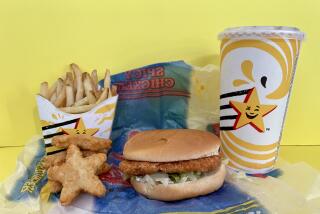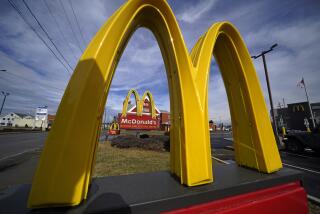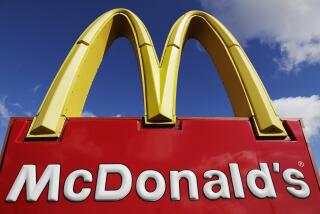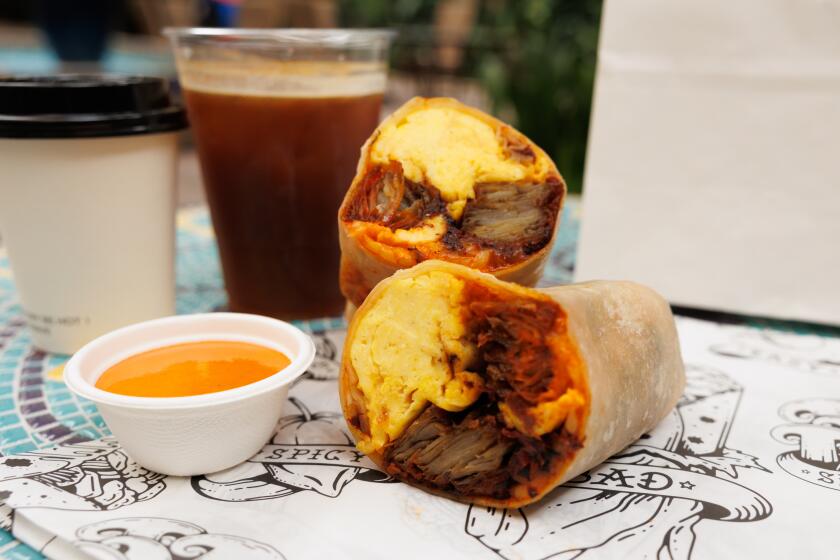Cutting calories is good business for restaurants, study says
- Share via
Chain restaurants have been nudged and cajoled for years to ditch mammoth portion sizes and high-calorie choices. But perhaps the best motivation to lower-calorie, more healthful menu items is here: profit. A report released Thursday calls lower-calorie menu choices “just good business.”
“We found that those restaurant chains that were growing their lower-calorie items, they demonstrated business advantages,” Hank Cardello, lead author of the report from the think tank Hudson Institute, said Thursday at a news conference to discuss the report.
“These are not just nice-to-have items, these are necessary parts of the portfolio.”
Restaurants are in business to make money, and in this case, Cardello said, they can do the right thing for customers’ health “because it makes sense to your bottom line.”
Dr. James Marks, a senior vice president at the Robert Wood Johnson Foundation, which funded the study, and a former assistant surgeon general, called the findings in the report “exciting.”
“They say the right and profitable are not mutually exclusive,” he said.
Cardello and colleagues looked at 21 of the nation’s largest restaurant chains -- fast-food companies such as McDonald’s and Taco Bell, and sit-down companies including Olive Garden and Outback Steakhouse. Those companies account for $102 billion in annual sales.
From 2006 to 2011, lower-calorie food and drink outperformed other choices in 17 of those chains, the report said.
This news comes as the federal government prepares to finalize a mandate for nutrition labeling, including calorie counts, on the menus of restaurant chains with more than 20 outlets.
That is one of the many efforts -- public and private -- to bring the obesity epidemic under control. In 1990, the obesity rate was 15% or lower in every state; today 39 states have obesity rates among adults at more than 25%.
“Our nation’s health and economic vitality are at risk because of the epidemic,” Marks said Thursday at the news conference. “The stakes couldn’t be any higher.”
For its study, the Hudson Institute set a 500-calorie limit for a sandwich or entrée to be called lower-calorie. For side dishes, appetizers and desserts, the limit was 150 calories. For an eight-ounce drink, 50 calories. The study did not consider other attributes of the foods.
Over the five years, the chains reported an increase of 472 billion servings of lower-calorie foods and beverages -- and a decrease of 1.3 billion servings of traditional items, the report said.
The lower-calorie choices are not always advertised as better, Cardello said. “The minute you tell someone, ‘Oh, by the way, there’s a healthier item on the menu,’ everybody runs the other way.”
Cardello is a former food industry executive who worked at Coca-Cola, General Mills and other companies. In 2001, he issued a report on supermarket goods, which showed similar results.
The report showed the chains it studied generated a 5.5% increase in same-store sales, compared with a 5.5% decline among chains selling fewer lower-calorie servings.
The lower-calorie food choices were more prominent in the fast-food industry, not surprising, Cardello said, “because you can have some pretty big plates served in the sit-down restaurants.” And the lower-calorie beverages were more apparent in sit-down restaurants, where people drink more coffee versus the full-sugar sodas often ordered in fast-food spots, he said.
The Hudson Institute is a nonpartisan policy research organization, and the Robert Wood Johnson Foundation focuses on health.
@mmacvean on Twitter
More to Read
Eat your way across L.A.
Get our weekly Tasting Notes newsletter for reviews, news and more.
You may occasionally receive promotional content from the Los Angeles Times.











